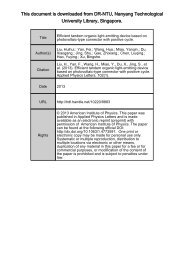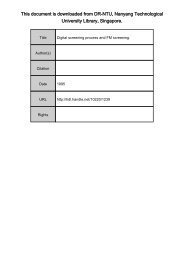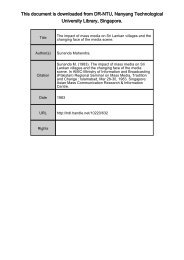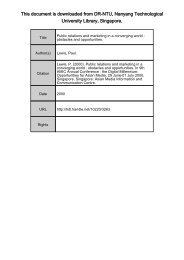annel Length and External Series Resistance Models of Scaled LDD ...
annel Length and External Series Resistance Models of Scaled LDD ...
annel Length and External Series Resistance Models of Scaled LDD ...
Create successful ePaper yourself
Turn your PDF publications into a flip-book with our unique Google optimized e-Paper software.
IEEE TRANSACTIONS ON ELECTRON DEVICES, VOL. 48, NO. 5, MAY 2001 1001<br />
reduction can be utilized to improve the low-frequency noise performance<br />
<strong>of</strong> analog circuits implemented in triple-well CMOS technologies<br />
[15]–[17].<br />
ACKNOWLEDGMENT<br />
The authors are grateful to Dr. G. Bosman for valuable comments<br />
<strong>and</strong> suggestions.<br />
REFERENCES<br />
[1] F. N. Hooge, “1/f noise,” Physica, vol. 83B, pp. 14–23, 1976.<br />
[2] L. K. J. V<strong>and</strong>amme, “Model for 1/f noise in MOS transistors biased in<br />
the linear region,” Solid-State Electron., vol. 23, pp. 317–323, 1980.<br />
[3] A. L. McWhorter, Semiconductor Surface Physics. Philadelphia, PA:<br />
Univ. <strong>of</strong> Pennsylvania Press, 1957, pp. 207–228.<br />
[4] S. Christensson, I. Lundstrom, <strong>and</strong> C. Svensson, “Low frequency noise<br />
in MOS transistors—I (Theory),” Solid-State Electron., vol. 11, pp.<br />
797–812, 1968.<br />
[5] , “Low frequency noise in MOS transistors—II (Experiment),”<br />
Solid-State Electron., vol. 11, pp. 813–820, 1968.<br />
[6] F. M. Kaassen, “Characterization <strong>of</strong> low 1/f noise in MOS transistors,”<br />
IEEE Trans. Electron Devices, vol. ED-18, pp. 887–891, Oct. 1971.<br />
[7] G. Reimbold, “Modified 1/f trapping noise theory <strong>and</strong> experiments in<br />
MOS transistors biased from weak to strong inversion-Influence <strong>of</strong> interface<br />
states,” IEEE Trans. Electron Devices, vol. ED-31, pp. 1190–1198,<br />
Sept. 1984.<br />
[8] K. H. Duh <strong>and</strong> A. van der Ziel, “Flicker noise in MOSFET’s with<br />
gate voltage-dependent mobility,” Solid-State Electron., vol. 27, pp.<br />
459–461, 1984.<br />
[9] C. Jakobson, I. Bloom, <strong>and</strong> Y. Nemirovsky, “1/f noise in CMOS transistors<br />
for analog applications from subthreshold to saturation,” Solid-State<br />
Electron., vol. 42, no. 10, pp. 1807–1817, 1998.<br />
[10] S. L. Jang, H. K. Chen, <strong>and</strong> M. C. Hu, “Low frequency 1/f noise model<br />
for short <strong>LDD</strong> MOS FET’s,” Solid-State Electron., vol. 42, no. 6, pp.<br />
891–899, 1998.<br />
[11] J. Brini, G. Ghibaudo, G. Kamarinos, <strong>and</strong> O. Roux-dit-Buisson, “Scaling<br />
down <strong>and</strong> low frequency noise in MOSFET’s,” Amer. Inst. Phys., pp.<br />
31–48, 1993.<br />
[12] M. H. Tsai <strong>and</strong> T. P. Ma, “The impact <strong>of</strong> device scaling on the current<br />
fluctuations in MOSFET’s,” IEEE Trans. Electron Devices, vol. 41, pp.<br />
2061–2221, Nov. 1994.<br />
[13] H. S. Park <strong>and</strong> A. van der Ziel, “Noise measurement in ion implanted<br />
MOSFET’s,” Solid-State Electron., vol. 26, no. 8, pp. 747–751, 1983.<br />
[14] M. J. Deen <strong>and</strong> Y. Zhu, “1/f noise in n-ch<strong>annel</strong> MOSFET’s at high<br />
temperatures,” Amer. Inst. Phys., pp. 165–188, 1993.<br />
[15] T. Takayanagi, K. Sawada, T. Sakurai, Y. Parameswar, S. Tanaka,<br />
N. Ikumi, M. Nagamatsu, Y. Kondo, K. Minagawa, J. Brennan, P.<br />
Hsu, P. Rodman, J. Bratt, J. Scanlon, M. Tang, C. Joshi, <strong>and</strong> M.<br />
N<strong>of</strong>al, “Embedded memory design for a four issue superscaler RISC<br />
microprocessor,” in Proc. IEEE Custom Integrated Circuits Conf.,<br />
1994, pp. 585–590.<br />
[16] M. Takada, K. Nakamura, <strong>and</strong> T. Yamazaki, “High speed submicron<br />
BiCMOS memory,” IEEE Trans. Electron Devices, vol. 42, pp. 497–505,<br />
Mar. 1995.<br />
[17] W. Muth, “Matrix method for latch-up free demonstration in a<br />
triple-well bulk-silicon technology,” IEEE Trans. Nucl. Sci., vol. 39, pt.<br />
I, pp. 396–400, Mar. 1992.<br />
[18] Y. Taur <strong>and</strong> T. H. Ning, Fundamentals <strong>of</strong> Modern VLSI Devices.<br />
Cambridge, U.K.: Cambridge Univ. Press, 1998.<br />
[19] F. Stern <strong>and</strong> W. E. Howard, “Properties <strong>of</strong> semiconductor inversion<br />
layers in the electric quantum limit,” Phys. Rev., vol. 163, pp. 816–835,<br />
1967.<br />
[20] Y. Ohkura, “Quantum effects in Si n-MOS inversion layer at high<br />
substrate concentration,” Solid-State Electron., vol. 33, pp. 1581–1585,<br />
1990.<br />
[21] F.-J. Huang <strong>and</strong> K. K. O, “Schottky-clamped NMOS transistors implemented<br />
in a conventional 0.8-m CMOS process,” IEEE Electron Device<br />
Lett., vol. 19, pp. 326–328, Sept. 1998.<br />
Effective Ch<strong>annel</strong> <strong>Length</strong> <strong>and</strong> <strong>External</strong> <strong>Series</strong> <strong>Resistance</strong><br />
<strong>Models</strong> <strong>of</strong> <strong>Scaled</strong> <strong>LDD</strong> pMOSFETs Operating in a Bi-MOS<br />
Hybrid-Mode Environment<br />
Siau Hing Lionel Seah, Kiat Seng Yeo, Jian Guo Ma, <strong>and</strong><br />
Manh Anh Do<br />
Abstract—The effective ch<strong>annel</strong> length <strong>and</strong> total external series<br />
resistance<br />
<strong>of</strong> deep submicron lightly doped drain (<strong>LDD</strong>)<br />
pMOSFETs, operating in a Bi-MOS hybrid-mode environment, have<br />
been modeled as functions <strong>of</strong> bias <strong>and</strong> temperature. The accuracy <strong>of</strong> the<br />
device threshold voltage used in the <strong>and</strong> extraction routine<br />
is discussed. The proposed models have been verified for temperature<br />
ranging from 223 K to 398 K <strong>and</strong> source-to-body voltage 0 V<br />
conditions.<br />
Index Terms—Deep submicron, effective ch<strong>annel</strong> length, external series<br />
resistance, hybrid-mode, lightly doped drain (<strong>LDD</strong>), temperature-dependent.<br />
I. INTRODUCTION<br />
The L e <strong>and</strong> R TOText are important parameters needed to accurately<br />
model the I-V characteristics <strong>of</strong> short-ch<strong>annel</strong> <strong>LDD</strong> MOSFETs<br />
[1]. Most analyses in the literature (e.g., [2]–[12]) either ignore the<br />
body terminal <strong>of</strong> the devices, assume the body <strong>and</strong> source terminals<br />
having the same potential, or consider the source-body junction<br />
in reverse biased mode. Recently, hybrid-mode devices employing<br />
lateral p-n-p BJT in a pMOS structure have been brought into attention<br />
due to their high current gain <strong>and</strong> simple technology [13]–[15].<br />
For a device operating in a Bi-MOS hybrid-mode environment, its<br />
gate <strong>and</strong> body terminals may be biased independently such that potential<br />
across the source-body junction becomes greater than 0 V,<br />
while maintaining the MOSFET in active mode. This requirement<br />
has prompted the question <strong>of</strong> whether or not L e <strong>and</strong> R TOText commonly<br />
extracted from the experimental data remain valid for V SB 0<br />
V. The knowledge <strong>of</strong> such dependency on the body bias is important<br />
to ensure proper prediction <strong>of</strong> the device performance in hybrid-mode<br />
operation.<br />
II. DEVICE STRUCTURES AND MEASURING EQUIPMENT<br />
The device structure used in the measurement consists <strong>of</strong> a series<br />
<strong>of</strong> silicon p-ch<strong>annel</strong> <strong>LDD</strong> MOSFETs fabricated with a gate oxide<br />
thickness t ox <strong>of</strong> 5 nm. The ch<strong>annel</strong> width W for all devices is 20<br />
m, whereas the gate length L varies from 1 m down to 0.25<br />
m. N-well implantation was formed using phosphorus <strong>of</strong> 2 2 10 13<br />
cm 02 dosage <strong>and</strong> an energy level <strong>of</strong> 600 keV. The drain/source<br />
implantation was carried out using boron with a dose <strong>of</strong> 3 2 10 15<br />
cm 02 <strong>and</strong> an energy level <strong>of</strong> 30 keV. The p 0 <strong>LDD</strong> implants were<br />
established with a dose <strong>of</strong> 2 2 10 14 cm 02 <strong>and</strong> an energy level<br />
<strong>of</strong> 20 keV. The p + junction depth X j <strong>and</strong> the p-<strong>LDD</strong> junction<br />
depth r j are approximately 0.15 m <strong>and</strong> 0.075 m, respectively. A<br />
ch<strong>annel</strong> implant dose <strong>of</strong> 3 2 10 12 cm 02 <strong>and</strong> an energy level <strong>of</strong> 70<br />
keV is added for threshold voltage adjustment. Device measurements<br />
were performed using a semiconductor parameter analyzer <strong>and</strong> a<br />
TEMPTRONIC system which controls the temperature <strong>of</strong> the wafer<br />
Manuscript received June 19, 2000; revised September 22, 2000. The review<br />
<strong>of</strong> this brief was arranged by Editor M. Hirose.<br />
The authors are with the Division <strong>of</strong> Circuits <strong>and</strong> Systems, School <strong>of</strong> Electrical<br />
<strong>and</strong> Electronic Engineering, Nanyang Technological University, Singapore<br />
639798.<br />
Publisher Item Identifier S 0018-9383(01)03255-5.<br />
0018–9383/01$10.00 © 2001 IEEE






